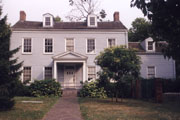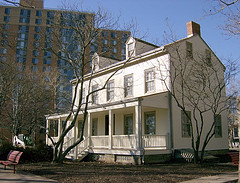This simple well-proportioned house, built for James Blackwell between 1796 and 1804, is the sole surviving building on Roosevelt Island which dates from the period when the island was still privately held property. The Blackwell family owned and farmed the island from the late 17th century until 1828, when it was sold to the City of New York. Blackwell’s Island, as it was long known, had been inherited by Mary Manningham Blackwell from her stepfather, Captain John Manning.
Captain Manning was granted a “patent” on the island by the British Governor Nicolls in 1668, a fortunate circumstance, since five years later, after mismanaging his command of New York’s Fort James during a Dutch attack, he was tried by court martial and publicly disgraced. Manning moved to his island retreat and evidently found solace there. Reverend Charles Wolley, writing in 1701, tells us that he had often gone to Manning’s Island to visit the Captain, “whose entertainment was commonly a bowl of rum-punch.”
 In Dutch times the island was known as Varckens Eylandt, which translates to Hog Island. It was purchased from two Indian chiefs by Governor Wouter van Twiller in 1637 and was already being farmed by 1639 under land grants from the Amsterdam Chamber of the West India Company. Jan Alteras, Francois Fyn, Jonas Bronck and Laurens Duyts all farmed the island during the mid 17th century. The last of these by 1658, defaulted on his lease. But Duyt’s misconduct was far worse in the respects- he was banished from the province for “selling his wife into immoral slavery and for gross immoralities committed by himself.” Hog Island was confiscated by the British in 1667. During the Revolutionary War the island was occupied by the British and in 1782, when peace negotiations were in progress, American prisoners of war were quartered there.
In Dutch times the island was known as Varckens Eylandt, which translates to Hog Island. It was purchased from two Indian chiefs by Governor Wouter van Twiller in 1637 and was already being farmed by 1639 under land grants from the Amsterdam Chamber of the West India Company. Jan Alteras, Francois Fyn, Jonas Bronck and Laurens Duyts all farmed the island during the mid 17th century. The last of these by 1658, defaulted on his lease. But Duyt’s misconduct was far worse in the respects- he was banished from the province for “selling his wife into immoral slavery and for gross immoralities committed by himself.” Hog Island was confiscated by the British in 1667. During the Revolutionary War the island was occupied by the British and in 1782, when peace negotiations were in progress, American prisoners of war were quartered there.
James and Jacob Blackwell, who had inherited the island from their father Jacob, found themselves in financial straits after the Revolutionary War and attempted to sell the property. In an advertisement of 1784 James was able to boast that his 107 acre island, “was about four miles from the city,” included among other amenities, “two small Dwelling Houses, a Barn, Bake, and Fowl House, a Cyder Mill, a large orchard, stone quarries and running springs.” A buyer could not be found, but by 1796 James Blackwell’s financial condition must have improved since it was about this time that the Blackwell House was built.
 With the purchase of Blackwell’s Island by the City, its agricultural use gave way to institutional development, beginning in 1829 with the erection of the penitentiary. The Blackwell House became the residential quarters for various institutional administrators. In the late 19th century the warden of the island’s Almshouse lived here. The house was abandoned during the 20th century and by the late 1960’s was in an advanced state of decay, its only hope for survival being complete restoration. The New York State Urban Development Corporation, as part of its redevelopment program for the island, instituted a survey of existing structures.
With the purchase of Blackwell’s Island by the City, its agricultural use gave way to institutional development, beginning in 1829 with the erection of the penitentiary. The Blackwell House became the residential quarters for various institutional administrators. In the late 19th century the warden of the island’s Almshouse lived here. The house was abandoned during the 20th century and by the late 1960’s was in an advanced state of decay, its only hope for survival being complete restoration. The New York State Urban Development Corporation, as part of its redevelopment program for the island, instituted a survey of existing structures.
On the basis of recommendations made by the Landmarks Preservation Commission, a survey by historian Loring McMillen in 1969, and a report prepared the same year by noted architectural historian Henry Russell Hitchcock, the Blackwell House was assessed worthy of preservation and restoration. The well known New York architect, Giorgio Cavaglieri, was commissioned to evaluate the buildings on the island and which were of special interest with a view to preserving them. In 1973, he carried out a complete and highly sympathetic restoration of Blackwell House.
This unpretentious clapboard farmhouse, built in the vernacular style of the late 18th century, now consists of a two-story main section and a one-story kitchen wing, constructed soon after the completion of the main building. A larger addition at the north, of later date, was razed during restoration and a root cellar entrance was constructed at the northeast corner of the main building. On the east, a spacious one story front porch has been restored and rests on the original stone foundations. A simple wood rail surrounds it, and the wood shingled roof rests elegantly on slim Ionic columns. This facade like that on the west, has two windows at each side of the simple central doorway, and five at the second story, all with six-over-six sash. A delicately scaled dentil course appears beneath the eaves of the gabled roof. Pairs of dormers project from this roof at the east and west. On the the west side, the doorway is sheltered by a simple pedimented portico, an addition in the Greek revival style.
The Blackwell House is one of the few farmhouses in New York dating from the years immediately after the Revolutionary War. Now utilized as a community center, it still rests on its original site, now a handsomely landscaped setting , which preserves much of the proper scale and relationship of the building to its surroundings.
farmhouses in New York dating from the years immediately after the Revolutionary War. Now utilized as a community center, it still rests on its original site, now a handsomely landscaped setting , which preserves much of the proper scale and relationship of the building to its surroundings.
